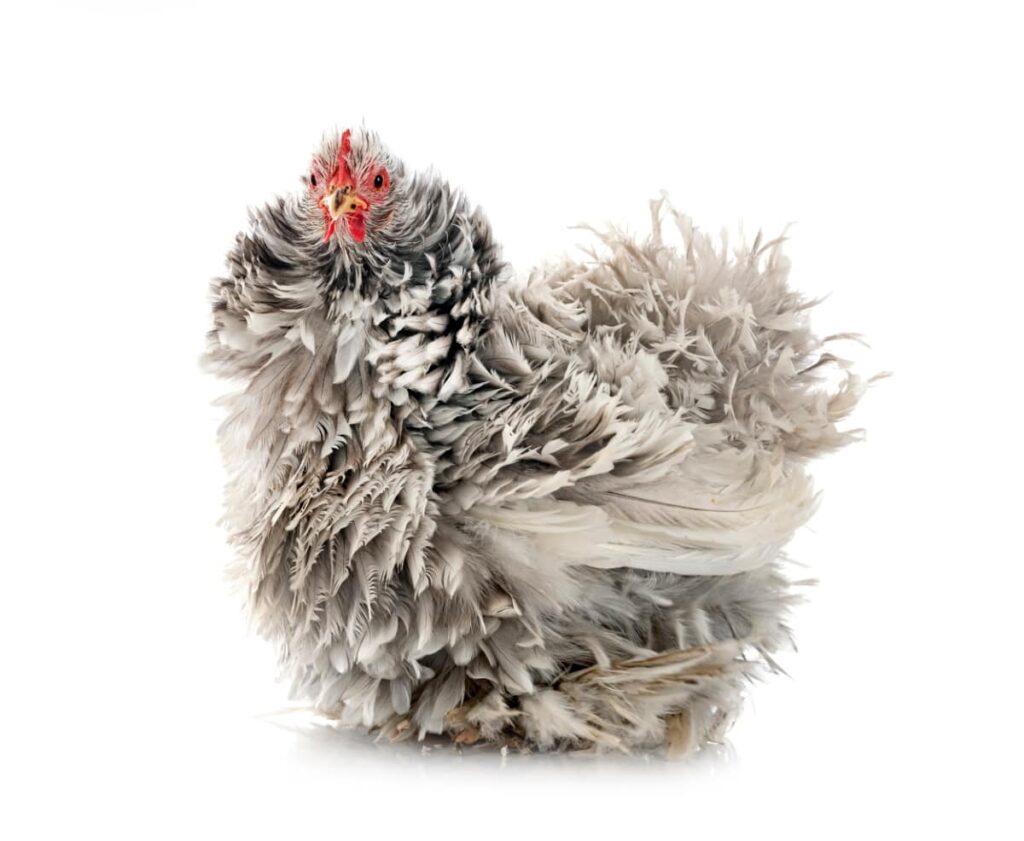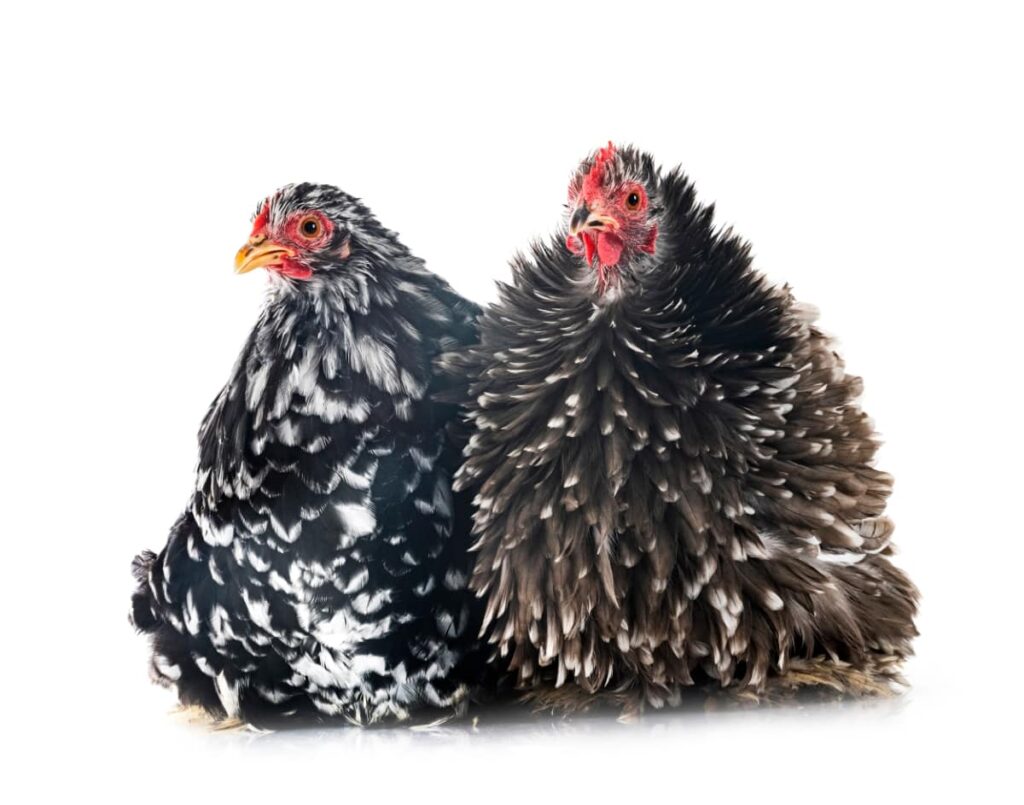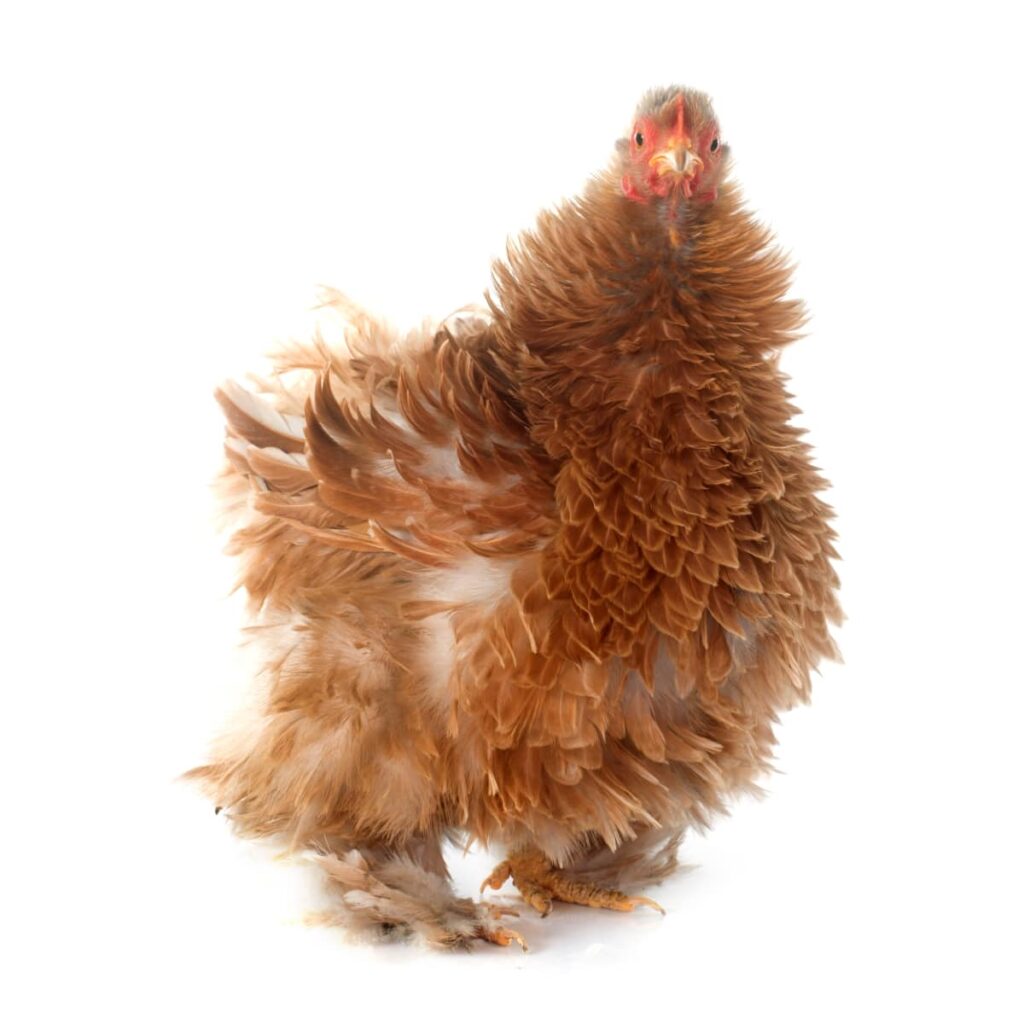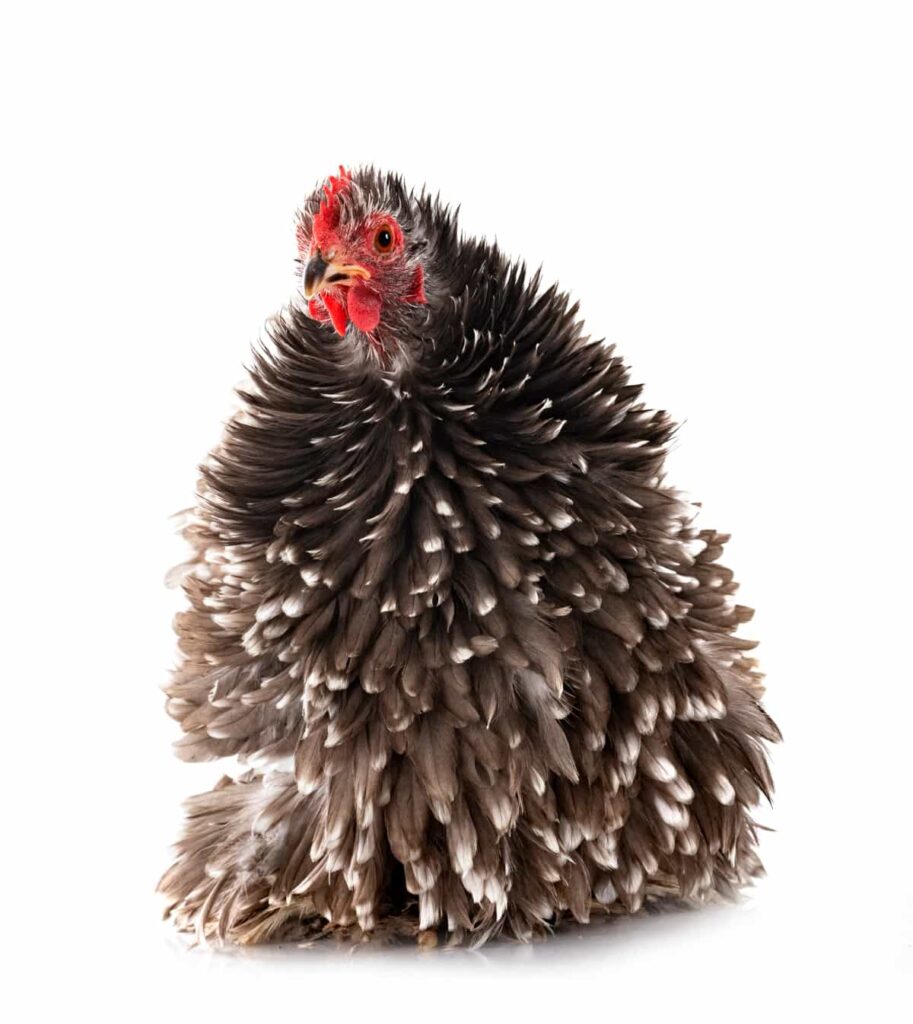Frizzle chickens are distinct for their unique curled feathers, giving them a fluffy and whimsical appearance. They exhibit friendly personalities, making them popular among backyard breeders and poultry enthusiasts. They are hardy birds, adaptable to various climates, and known for their egg-laying capabilities, making them prized additions to any flock.

How to Raise Frizzle Chickens
History and Origin
The exact origins of Frizzle chickens remain elusive, though they’re thought to have emerged in Asia, possibly in China or the East Indies. Historical records indicate their presence in Western countries by the 1600s, suggesting their early global dispersal. Charles Darwin acknowledged them in the 1800s, labeling them “Caffie Fowl.”
Frizzle Chicken Facts
- Lifespan: Frizzle chickens typically have a lifespan of around 5 to 8 years, although this varies based on factors like genetics, diet, and the care
- Price: On average, Frizzle baby chicken may range from $5 to $15 each, while adult birds can cost from $15 to $50 or more, especially for rare or show-quality specimens.
- Size: Frizzle chickens are available in both standard and bantam sizes. Standard Frizzles typically weigh around 2.7kg for hens and 3.6kg for roosters. In contrast, Frizzle bantams are diminutive in size, with hens weighing approximately 0.5kg and roosters around 0.75kg.
- Colors: Frizzle chickens exhibit a wide array of colors and patterns, including single colors like white, black, and buff, as well as various combinations and markings such as mottled, laced, or barred.
Temperament and Behavior: Frizzle chickens are known for their friendly and docile temperament, making them excellent additions to family flocks. They often exhibit curious and friendly behavior, enjoying interaction with their human caretakers. Frizzles are generally calm and easy to handle, making them suitable for both novice and experienced poultry enthusiasts alike.
Raising Frizzle Chickens
Choosing Your Chickens
Selecting Healthy Birds
When choosing chickens, look for bright eyes, clean feathers, and active behavior. Avoid birds with signs of illness like lethargy or discharge. Check for well-formed legs and feet, and ensure they have a good appetite. Healthy birds should have a lively demeanor and interact with their surroundings.
Understanding Genetic Variations
Genetic variations in chickens determine traits like color, feather type, and size. Breeding practices influence these traits, with some breeds exhibiting specific characteristics like Frizzle chickens’ curly feathers. Understanding genetics helps breeders select for desired traits, ensuring healthy and robust offspring that meet breed standards and individual preferences.
Setting Up the Coop
Coop Design and Size
A well-designed chicken coop provides adequate space for roosting, nesting, and movement. Aim for at least 2-4 square feet per chicken inside the coop, with additional space in the outdoor run. As Frizzle chicken coop requirements, ensure proper ventilation, insulation, and easy access for cleaning to promote a healthy and comfortable environment for your frizzle chickens.
Protecting from Predators
Protect your chickens from predators by securing the coop with sturdy fencing and hardware cloth to deter burrowing and climbing. Install predator-proof locks on windows and doors, and consider adding motion-activated lights or alarms. Regularly inspect the coop for signs of damage and reinforce weak spots to keep your chickens safe from harm.
In case you missed it: My Pet Chicken: How to Raise from Scratch

Creating a Safe Run
Space Requirements
For a safe chicken run, provide 10 square feet of space at least per bird to allow ample room for exercise and natural behaviors like scratching and dust bathing. Ensure the run is adequately fenced with wire mesh buried to deter digging predators and covered to protect from aerial threats.
Providing Shelter and Security
Offer shelter within the run, such as a sturdy coop or covered area, protecting from the elements and predators. Ensure the shelter has secure doors and windows and is well-ventilated. Incorporate roosts and nesting boxes for comfort and regularly inspect for any potential hazards or vulnerabilities to maintain security.
Feeding Frizzle Chickens
Types of Feed for Different Ages
For young Frizzle chickens, provide starter feed with high protein content (18-20%) for optimal growth. As they mature, they transition to grower feed (16-18% protein) until they start laying eggs, then switch to layer feed (16-18% protein) to support Frizzle chicken egg production. Supplement with treats like fruits and vegetables.
Importance of Water and Supplements
Water is essential for hydration, digestion, and overall health. Provide clean, fresh water at all times, especially during hot weather. Supplements like calcium and grit aid in eggshell formation and digestion, respectively. Ensure access to grit for chickens to grind food in their gizzards, promoting proper digestion.
Health and Veterinary Caring for Frizzle Chicken
Regular Health Checks
Perform routine health checks on Frizzle chickens, examining their eyes, feathers, and behavior for signs of illness or injury. Monitor their weight, droppings, and overall activity levels. Schedule regular visits with a poultry veterinarian for comprehensive Frizzle chicken health care assessments and vaccinations to prevent common diseases and ensure the well-being of the flock.
Common Ailments and Treatments
Frizzle chickens may experience common ailments like respiratory infections, parasites, and injuries. Treatments include antibiotics for bacterial infections, dewormers for parasites, and wound care for injuries. Provide supportive care like proper nutrition, warmth, and isolation for sick birds to facilitate recovery and prevent the illness from spreading within the flock.
Grooming Frizzle Chicken Feathers and Feather Care
Managing Frizzle Feathers
Regularly inspect Frizzle chicken feathers for damage or matting, trimming any excessively curled or tangled feathers to maintain their health and appearance. Avoid over-grooming, as it can cause stress and disrupt the natural insulation provided by their plumage. Provide a clean and dry environment to minimize feather-related issues.
Bathing and Parasite Prevention
While Frizzle chickens typically groom themselves adequately, occasional dust baths can help maintain their plumage and control parasites like mites and lice. Provide a shallow container with dusting material like diatomaceous earth or sand.
Egg Laying Essentials
Nesting Box Setup
Create comfortable and private nesting areas by placing clean and dry nesting boxes filled with soft bedding material, like straw or wood shavings, in a quiet corner of the coop. Ensure proper ventilation and adequate spacing to accommodate multiple hens simultaneously, encouraging natural egg-laying behavior.
Maximizing Egg Production
Promote optimal egg production by feeding with a diet rich in protein and calcium to support egg development. Maintain a consistent light cycle with 14-16 hours of daylight to stimulate reproductive hormones. Minimize stressors, such as overcrowding or predator threats, and ensure access to fresh water and nesting areas to encourage regular laying.
Frizzle Chicken Behavior and Socialization
Interaction with Humans and Other Animals
Frizzle chickens enjoy gentle interaction with humans, becoming accustomed to handling and bonding with their caretakers. They can also coexist peacefully with other backyard animals like dogs or cats if introduced gradually and supervised. Positive socialization enriches their environment and strengthens their trust and confidence.
Understanding Chicken Behavior
Chicken behavior is influenced by instincts and social hierarchy. They exhibit natural behaviors like foraging, dust bathing, and roosting. Understanding their body language, vocalizations, and pecking order dynamics helps interpret their needs and behaviors, fostering a harmonious and enriching environment within the flock.
Seasonal Care Considerations
Winterizing Your Coop
Prepare for winter by insulating the coop to retain warmth, sealing drafts, and providing supplemental heat sources like heat lamps or heated waterers. Use deep bedding for insulation and ensure adequate ventilation to prevent moisture buildup. Provide extra roosting space and feed high-energy foods to help chickens stay warm.
Summer Heat Management
Manage summer heat by providing ample shade and ventilation in the coop and run. Use fans or misters to cool the environment and provide frozen treats like watermelon or ice cubes to help chickens stay hydrated. Ensure access to fresh water at all times and monitor for signs of heat stress, such as panting or lethargy.
In case you missed it: How to Raise Kikiriki Chickens: Origin, Behavior, Care, and Breed Information

Legal and Ethical Considerations
Understanding Local Laws
Familiarize yourself with local regulations regarding chicken keeping, including zoning ordinances, noise restrictions, and flock size limits. Obtain necessary licenses and comply with regulations on coop size, sanitation, and property boundaries to ensure legal compliance and prevent potential fines or penalties.
Ethical Keeping Practices
Practice ethical chicken keeping by providing spacious and clean living conditions, proper nutrition, and veterinary care. Allow for natural behaviors like scratching and foraging, and avoid overcrowding or unnecessary stress. Treat chickens with kindness, recognizing them as sentient beings deserving of humane treatment and consideration for their welfare.
In case you missed it: Vorwerk Chicken Breed: History, Origin, Characteristics, Price and Egg Production

Conclusion
In essence, Frizzle chickens embody a delightful blend of charm, curiosity, and beauty, making them a beloved and cherished part of the poultry world. Whether admired for their unique appearance or cherished as friendly companions, these feathered friends continue to captivate and inspire those who have the pleasure of encountering them.
Note: The images presented in this post are intended solely for representation purposes. The images are meant to serve as visual aids and should not be relied upon as accurate representations of their real-life counterparts.
- Sheep Farming Business Plan for Beginners
- Aquaponic Farming at Home: A Step-By-Step Guide
- Profitable Village Farming Business Ideas in 2024
- High-Yield Aquaculture: Fast-Growing Fish for Farming
- Effective Fish Pond Construction Techniques for Beginners
- Irrigation and Water Management in Pineapple Farming
- Blossom to Harvest: Mastering Flowering and Pollination in Papaya Farming
- Pig Fattening Essentials: From Selection to Sale for Beginners
- Raising Wagyu Cattle: A Complete Guide for Premium Beef Production
